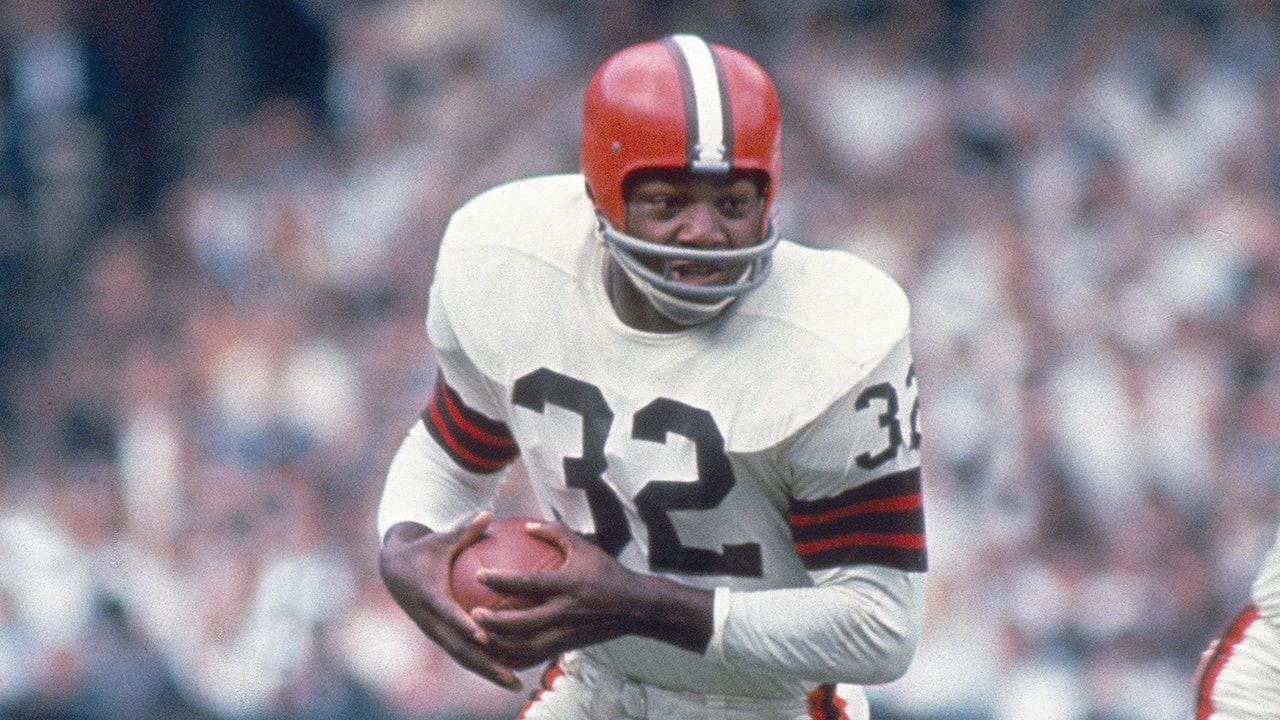Synthaholic
Diamond Member
- Jul 21, 2010
- 75,712
- 73,476
- 3,605
He was the real deal.
Jim Brown, who was often called the greatest football player of his time but who gave up the sport at the peak of his career in the 1960s, declaring himself a “highly paid, over-glamorized gladiator,” and turned instead to acting and activism, died May 18 at his home in Los Angeles. He was 87.
His wife, Monique Brown, announced the death in an Instagram post but did not cite a cause.
Mr. Brown was one of the most gifted all-around athletes of the past century. He excelled in lacrosse, basketball, and track and field and was virtually unstoppable during his nine years as a powerhouse fullback with the Cleveland Browns in the 1950s and ’60s.
In breaking almost every rushing record in the National Football League, he “was something completely new,” journalist and sports author David Halberstam wrote in 2001. “I have never again seen a running back who was so much better than everyone else who did what he did at the time he was doing it. He dominated his field in his era like few athletes ever have, perhaps matched only by Babe Ruth and Bill Russell.”
At 6-foot-2 and about 230 pounds, Mr. Brown had an unmatched blend of strength and speed that enabled him to lead the NFL in rushing in eight of his nine years with the Browns. When he retired after the 1965 season, his 12,312 career rushing yards were a record that would stand for 19 years, until broken by Walter Payton of the Chicago Bears. Mr. Brown ran for more than 1,000 yards in a season seven times, and his 1,863 rushing yards in 1963 stood as the NFL record until surpassed by the Buffalo Bills’ O.J. Simpson 10 years later.
Mr. Brown helped lead Cleveland to the NFL championship in 1964 and was elected to the Pro Football Hall of Fame in 1971, in his first year of eligibility.
“As a pure runner he stands alone,” his coach in Cleveland, Paul Brown, wrote in a 1979 autobiography. “Jim combined power, acceleration, speed and great balance with an inner toughness that never conceded the slightest edge to anybody.”
Away from the playing field, however, Mr. Brown could be a complex, contradictory and troubled man. His career began at the dawn of the civil rights movement, and he was acutely aware of the double standards that prevailed in sports and society.
Even when he was named NFL rookie of the year in 1957, he wasn’t always allowed to stay at the same hotels or dine in the same restaurants as his White teammates. Mr. Brown became something of a symbolic figure early in his career, particularly when his team played Washington’s NFL franchise, whose owner, George Preston Marshall, stubbornly refused to put a Black player on the roster until 1962.
More at the link.
Jim Brown, Hall of Fame running back and actor, dies at 87
He dominated the NFL in the 1950s and ’60s, then left football for movies and activism
Jim Brown, who was often called the greatest football player of his time but who gave up the sport at the peak of his career in the 1960s, declaring himself a “highly paid, over-glamorized gladiator,” and turned instead to acting and activism, died May 18 at his home in Los Angeles. He was 87.
His wife, Monique Brown, announced the death in an Instagram post but did not cite a cause.
Mr. Brown was one of the most gifted all-around athletes of the past century. He excelled in lacrosse, basketball, and track and field and was virtually unstoppable during his nine years as a powerhouse fullback with the Cleveland Browns in the 1950s and ’60s.
In breaking almost every rushing record in the National Football League, he “was something completely new,” journalist and sports author David Halberstam wrote in 2001. “I have never again seen a running back who was so much better than everyone else who did what he did at the time he was doing it. He dominated his field in his era like few athletes ever have, perhaps matched only by Babe Ruth and Bill Russell.”
At 6-foot-2 and about 230 pounds, Mr. Brown had an unmatched blend of strength and speed that enabled him to lead the NFL in rushing in eight of his nine years with the Browns. When he retired after the 1965 season, his 12,312 career rushing yards were a record that would stand for 19 years, until broken by Walter Payton of the Chicago Bears. Mr. Brown ran for more than 1,000 yards in a season seven times, and his 1,863 rushing yards in 1963 stood as the NFL record until surpassed by the Buffalo Bills’ O.J. Simpson 10 years later.
Mr. Brown helped lead Cleveland to the NFL championship in 1964 and was elected to the Pro Football Hall of Fame in 1971, in his first year of eligibility.
“As a pure runner he stands alone,” his coach in Cleveland, Paul Brown, wrote in a 1979 autobiography. “Jim combined power, acceleration, speed and great balance with an inner toughness that never conceded the slightest edge to anybody.”
Away from the playing field, however, Mr. Brown could be a complex, contradictory and troubled man. His career began at the dawn of the civil rights movement, and he was acutely aware of the double standards that prevailed in sports and society.
Even when he was named NFL rookie of the year in 1957, he wasn’t always allowed to stay at the same hotels or dine in the same restaurants as his White teammates. Mr. Brown became something of a symbolic figure early in his career, particularly when his team played Washington’s NFL franchise, whose owner, George Preston Marshall, stubbornly refused to put a Black player on the roster until 1962.
More at the link.


